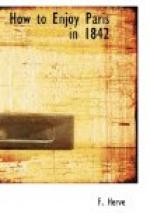At the same time it must be admitted that several of the best artists have not sent any pictures for the last few years, and particularly the present, when amongst the absentees might be cited Ingres, Horace Vernet, Ary Scheffer, Delaroche, etc., who it appears were all employed by the King or government; the consequence was, although there was an immense mass of large historical and scriptural subjects, it was what might have been called a most sorry display. Amongst the number one alone evinced a superiority of talent, and that was the taking of Mazagran by Phillippoteaux, which really had considerable merit, and the artist it appears passed some time in Algiers, and therefore was enabled to give a faithful representation of the inhabitants of the country. Of miscellaneous subjects, or what the French call tableau de genre, there were many most exquisite pictures, amongst the rest, the Miller, his Son and his Ass, by H. Bellange, which was so full of character and expression, that it needed not language to tell the tale; there were also several other pieces by the same artist, possessing equal merit. An Assembly of Protestants surprised by Catholic Troops, by Karl Girardet, was a most superior picture in Wilkie’s best style; Reading the Bible, by Edward Girardet, also exceedingly clever; but one of the most delightful pictures in the exhibition was by Gue, of Raymond of Toulouse reconciling himself to the Church; I never yet saw any performance of that artist but evinced some great merit, either the finest imagination, the most beautiful execution, or the utmost truth to nature, according to the subject he undertakes. I should certainly pronounce Gue as one of the best artists who now send their pictures to the Louvre; one he had two years since of the Crucifixion, at the annual Exhibition, which certainly was a most sublime composition, the approach of night, with a slight glare of parting light, was most admirably represented, and gave a sort of wild gloom which so beautifully harmonised with the nature of the subject; he had also introduced the dead rising from their tombs, which contributed to augment the solemn tone which pervaded the whole picture. However lightly or frivolously the mind might be engaged, one glance at this exquisite painting must at once strike awe into the beholder; it was true that there was a great similarity with one on the same subject, in the Louvre, by Karel Dujardin, but not sufficiently so to say it was borrowed, or to detract from its merit. T. Johanot had but one picture this year, which was very clever, as his always are; his subjects are mostly historical, and his illustrations of Walter Scott are universally known and admired. Schopin is another of the French artists whose pictures will always live, his females are so truly graceful, such sweetness of expression in their countenances; this year he did not shine so much as he has before, having but one picture, which was from Ruth and Boaz, and the latter was made to appear too old. A paralyzed old Man on an Ass, which his son was leading, was a true picture of nature, by Leleux; the vigour of the one and the feebleness of the other were admirably contrasted, although rather flat from wanting more shade.




